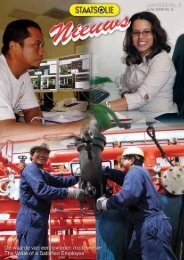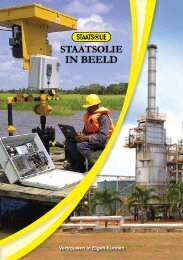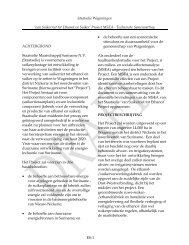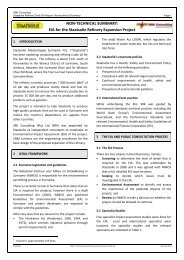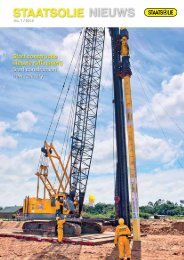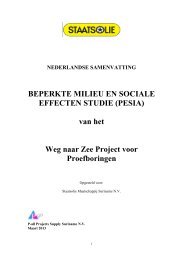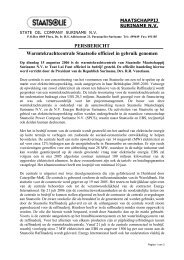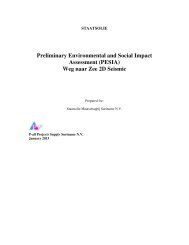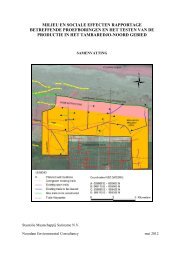(PESIA) Weg naar Zee 2D Seismic - Staatsolie
(PESIA) Weg naar Zee 2D Seismic - Staatsolie
(PESIA) Weg naar Zee 2D Seismic - Staatsolie
You also want an ePaper? Increase the reach of your titles
YUMPU automatically turns print PDFs into web optimized ePapers that Google loves.
P-all consultants <strong>Staatsolie</strong> Maatschappij Suriname N.V.<br />
<strong>PESIA</strong> <strong>Weg</strong> <strong>naar</strong> <strong>Zee</strong> <strong>2D</strong> <strong>Seismic</strong> 2012<br />
by the project<br />
11 Economic activities >><br />
What economic<br />
activities are expected to<br />
be impacted by the<br />
project<br />
12 Health risks >> Which<br />
health risks are coming<br />
along with the project<br />
Field survey<br />
Economic statistics.<br />
RGD policlinic<br />
Ministry of Health<br />
33<br />
Field survey conducted.<br />
Statistics LVV.<br />
Doctor Bilgoe<br />
interviewed<br />
Data collection for the base-line study was done in August and September 2012.<br />
For fieldwork only areas that are reasonably accessible over land and/or water were visited. No<br />
new access trails were made. Components of the environment are defined relative to the scope of<br />
this project out of a NIMOS list from: Environmental Assessment guidelines Volume V: Power<br />
Generation and Transmission Projects March 2005.<br />
Components of the social assessment were defined relative to the scope of this project out of a<br />
NIMOS list from: Environmental Assessment Guidelines Volume IV: Social Impact Assessment,<br />
March 2005.<br />
Experts used primary statistics like the census figures, the housing statistics and production<br />
statistics from the Ministry of Agriculture to describe the social and economic base-line. These<br />
figures were supplemented by information collected by interviewing stakeholders from the area.<br />
Experts also looked into changes in:<br />
• mangrove growth along the cost-line,<br />
• housing (urban) development,<br />
• agriculture development and,<br />
• other developments on private properties.<br />
The study area comprises two distinctly different environments: a Wetland and a Dry land Area.<br />
In order to conveniently describe the environment, the study area is divided in these two areas<br />
(Figure 3).




